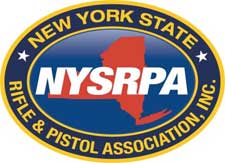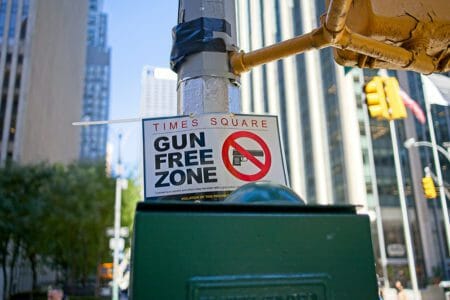
New York –-(Ammoland.com)- As a method of providing an update on our fight to overturn New York’s SAFE Act (“the Act”), we are providing this letter, in “Q and A” form, with the answers to questions you might have concerning the case.
Q: What is the current status of the proceedings in the New York action?
As you are aware, in the beginning of the case, we moved for a preliminary injunction. In this motion, we ask the Court to stop the provisions of the SAFE Act from taking effect while the lawsuit is ongoing.
In particular, we are seeking the court to enjoin the enforcement of the following provisions of the law:
- 1. The section making it unlawful to possess an ammunition feeding device containing more than seven rounds of ammunition.
- 2. The sections making it unlawful to possess, transport, ship, or dispose of, a large capacity ammunition feeding device (we are alternatively seeking to enjoin these
- provisions as applied to any such device manufactured before September 13, 1994).
- 3. Certain unintelligible portions of the section making it unlawful to possess a large capacity ammunition feeding device (if the court does not enjoin the entire section).
- 4. The sections which make it unlawful to possess a device that can be readily restored or converted to accept more than ten rounds of ammunition.”
- 5. The sections which make it unlawful to possess a device that can be readily restored or converted to accept more than ten rounds of ammunition, or a device that holds more than ten rounds as applied to tubular magazines.
- 6. The sections which define an “assault weapon” in part as certain rifles and shotguns as having a folding or telescoping stock, a pistol grip that protrudes conspicuously beneath the action of the weapon, or a thumbhole stock.
- 7. The sections which define an “assault weapon” as a semiautomatic shotgun with a fixed magazine capacity in excess of seven rounds or an ability to accept a detachable
- magazine.
The Defendants have opposed our Motion for Preliminary Injunction and have filed their own Motion to Dismiss and for Summary Judgment, which asks the Court to enter judgment determining that the SAFE Act is valid. In response to the State’s Motion for Summary Judgment, we have filed our own Motion for Summary Judgment. The briefing on these motions (which has been extensive) is complete.
Q: What will happen next?
Since briefing is complete, we believe the Court will schedule an oral argument on the motions. Normally, for cases involving these controversial of issues, courts will hold an oral argument, although the Court is not required to do so; as the issues involved in the motions are purely legal, no testimony is required and the Court may just rule on the papers that have been filed. We do not know, however, if the Court will have a hearing and when it will happen. The procedural rules do not require the Court either to set a hearing or to decide the motion within a specified amount of time. The time in which a court sets a motion for hearing and issues a decision on a matter is impacted by several factors, such as the judge’s schedule, pressing criminal trials, and the complexity of the issues involved. Every judge handles his or her caseload differently.
Given the issues involved, we believe the Court will do its best to hear and decide the motions as quickly as possible, but ultimately we have no control over that time frame. We have conveyed to the Court, and will continue to convey to the Court, our desire to move this matter along as quickly as possible.
Q: Will we get relief before January 15, 2014, the effective date of the requirement that all previously grandfathered magazines of more than 10 rounds must be discarded or sold out of state?
Possibly, but unlikely. While we understand that this portion of the law is a source of particular anger with members, the chance of the Court ruling to strike down or otherwise enjoin the law before that date really depends on how quickly the Court decides to either hold a hearing on our motion for preliminary injunction or issue a decision. As mentioned earlier, the Court has almost complete control over its schedule.
As described above, there are three motions pending: our Motion for Preliminary Injunction, Defendants Motion to Dismiss and for Summary Judgment, and our own Motion for Summary Judgment. The Court may rule on these motions at the same time, or it may rule on them separately.
The Motion for Preliminary Injunction asks the Court to enjoin, or stop, the enforcement of certain provisions of the Act while the lawsuit is ongoing. Concerning this motion, the Court has two options: (1) It can grant (either in whole or in part) our preliminary injunction request, which would stop the provisions described above from being enforced while the lawsuit is ongoing; or (2) It can deny our preliminary injunction request, which would not stop the provisions described above from being enforced while the lawsuit is ongoing. The second and third motions are the Defendants’ Motion to Dismiss or for Summary Judgment and our own Motion for Summary Judgment. If the Court grants the State’s motion in its entirety, then the case will be dismissed in favor of the Defendants. Similarly, if the Court grants our own Motion for Summary Judgment, then judgment will enter in favor of the plaintiffs. If the Court grants part of the Defendants’ motion, than the case will be dismissed in favor of the Defendants as to those parts of the law upon which the Court grants the motion. The same holds true, obviously, if the Court grants the Plaintiffs’ Motion in part. If the Court denies the motions in their entirety, then the case would continue to proceed as it is styled with all of our claims intact.
Given the complexity of the issues raised in the motions and the current caseload of the Court, it is unlikely (but not impossible) that the Court will rule on our motion for preliminary injunction before January 15 2014. We are sending a letter to the Court trying to get the Court to expedite a hearing on our preliminary injunction motion to stop the enforcement of the law, but it is unlikely that the Court will take action before the January 15, date.
Q: How is this lawsuit affected by other lawsuits challenging the NY law?
Many times when a law is enacted that infringes core rights, like the Act, there are multiple lawsuits filed seeking to stop the law from taking effect or otherwise being enforced. Sometimes, these actions proceed in harmony with each other; most times, they do not. For example, there have been other lawsuits filed which challenge the SAFE Act on various grounds that we may or may not have raised in our lawsuit. One suit has challenged the emergency manner in which the SAFE Act was
adopted. This was a potential basis for challenging the law that we considered, but rejected, at the onset of this litigation: our analysis and experience showed that courts do not get involved with the merits of “emergency” determinations, and have historically taken a completely permissive attitude towards legislative circumvention of these aging requirements. We therefore believe that a challenge on this basis would be quickly rejected (as the one brought by Robert Schulz on this same basis has
been), would detract from the strong arguments we have prepared, and could cause us to lose credibility with the court.
We believe that the lawsuit we have brought is well-crafted, and that the record supports the relief we are seeking. This was the product of a lengthy, deliberative process in which we analyzed many different approaches. Having a law invalidated is not an easy thing to accomplish, and we believe that the approach we have adopted and implemented gives us the best chance of success. This may be different from the approach taken by plaintiffs in other lawsuits, but it is the one that we
believe gives us the greatest chance of prevailing in the end. We hope this gives you an accurate picture of where things currently stand in this lawsuit0.
If you have follow up questions about any of the matters discussed in this letter, or the case in general, please do not hesitate to contact us. We welcome your call.
Thank you.Tom King
Cogito ergo sum armati
About:
The New York State Rifle & Pistol Association is the state’s largest and oldest firearms advocacy organization. Since 1871, our organization has been dedicated to the preservation of Second Amendment rights, firearm safety, education and training, and the shooting sports. Our membership consists of individuals and clubs throughout the state. We are a not-for-profit 501(c)4 organization and the official NRA-affiliated State Association in New York. Visit: www.nysrpa.org





It’s interesting how the NRA has brainwashed
It ‘s members into believing that common sense
Regulation of guns violates the Second Amendment
Yet these same NRA supporters find no problem
with laws regulating motor vehicles. Cars kill
Thousands every year and do do guns . West
Virginia Legislature recently passed a so called
Constitutional Carry law allowing citizens to carry
Hand guns ( concealed) without any gun training
Or background checks. The rational for this absurd
Law is the second amendment! Compare lakes
NY ‘s law is rational WV’s is NRA irrational !
Go cry on Bloombergs shoulder , Look at the fact of how many felons attempted to purchase firearms and are never arrested. Non-enforcement of the law.
So what that Virgina finally got back on board with the Constitution. What are you riding the Obama Socialist Fascist Train? You enjoy your tax dollars which is your earned money pissed away on crackheads and baby factory moms?
James owning and driving a motor vehicle is what is called a privilege. The 2nd Amendment is in the Constitution and the BILL OF RIGHTS. LEARN THE DIFFERENCE! Privileges like driving can be taken away RIGHTS CANNOT, they can only be forfeited by the individual by committing crimes against society.
The NRA hasn’t “brainwashed” anyone. It is YOU, and those such as yourself, that have NO CLUE as to what a RIGHT is. “Common sense” is a matter of perspective; what may be “common sense” to you, makes NO SENSE to ME, because I value FREEDOM, and you are apparently happy to have some B.S.-spewing bureaucrat decides what is “for your own good”. Show us some examples of “common sense” gun laws you support, and then explain how a CONSTITUTIONALLY-AFFIRMED, PRE-EXISTING CIVIL, HUMAN RIGHT must be comprised because you are too ignorant to understand the subject. It is NONE OF… Read more »
These days judges are not judicial, they’re political. Whatever political persuasion they are, that’s the way they’re going to vote, regardless of Constitutional issues. The liberals have shredded the Constitution, with the help of liberal judges. File all the lawsuits you want. New York is a liberal state, mostly because of New York City. The day is going to come when stronger measures are going to be needed to maintain our freedoms.
I greatly appreciate this update as a resident of NY State, a member of many gun rights organizations including the NYSRPA, an avid shooter, and Second Amendment advocate. However; I take great issue with the ammunition portion of the law that effects all gun owners in this state. This ammunition provision that bans online sales, and creates a registry is going to drive the price of ammunition up to the point that its going to cripple recreational shooting in this state. If recreational shooting and the shooting sports participation diminishes then future generations of sportsman are going to see smaller… Read more »